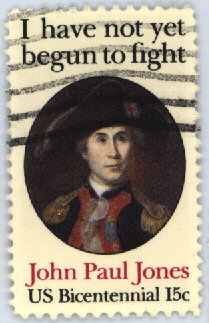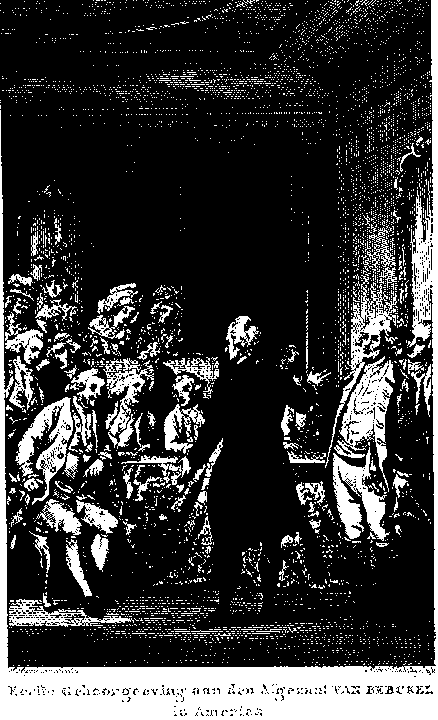Revolution
The American Declaration of Independence received great response in The Netherlands. The ideas of `The Age of Reason,' the writings of the French philosophers Voltaire, Montesquieu and Rousseau, had found their way into Holland but the debate had remained theoretical. The structure of the Dutch republic was by then suffering severely from petrifaction. The glories of the seventeenth century were a memory. A few ruling families ran the country on a patriarchal basis, with a Prince of Orange as stadholder. The news from America now brought hope to the enemies of this system. The revolt seemed a warning to the ruling families, who gave the Dutch people as small a share in their government as the English Parliament had granted the colonists. In America the social theories of the French philosophers were being put into practice. Support of the American cause became a natural rallying point for the opponents of the Dutch oligarchy. All classes were represented, including the more enlightened aristocrats.The merchants of Amsterdam again found themselves, by the very nature of their profession, on the side of freedom of trade and shipping. As early as 1775 they were in contact with the American rebels. The Dutch island of St. Eustatius in the Caribbean became the center of trade with the colonies, a trade which England naturally regarded as contraband. It was here that the very first salute was fired to the American flag. The trader Andrew Doria, entering the harbor of St. Eustatius on November 16, 1776, flew the newly designed flag (at that time without stars). The island's governor, Johan de Graaff, acknowledged her and saluted her with eleven shots from the fort.
British protests over this action were so vehement that he was called back to Holland to account for himself. However, the States-General, overriding the Stadholder's reluctance to offend England, immediately reinstated him as Governor of St. Eustatius. In 1781, a British fleet destroyed the installations on the island to put an erid to the trade with the rebels.
In the meantime France had recognized the new American republic and had declared war on England. A strong party in Holland wanted the Dutch government to follow the same policy. But Holland and England had been official allies for a hundred years. The Stadholder was a friend and relative of the English king.
The City of Amsterdam in the meantime, however, started its negotiations with the Americans in secret. A plan was drafted for a treaty of trade and friendship to become effective as soon as Holland would recognize the independence of the United States. But by then relations between Holland and England had deteriorated still further on the issue of the Dutch trade with the rebels. When England got hold of a copy of the secret treaty, it used it as a pretext to declare war on The Netherlands.
 Holland and the American colonies were now united against Britain.
In 1782 Holland formally recognized the independence of the United States,
the second country to do so. The new American envoy to The Hague,
John Adams, was proud `to have torn from England's bosom ... a faithful
ally... by availing himself of the still small voice of reason... without
money, without intrigue...'
The Credentials of John Adams
Holland and the American colonies were now united against Britain.
In 1782 Holland formally recognized the independence of the United States,
the second country to do so. The new American envoy to The Hague,
John Adams, was proud `to have torn from England's bosom ... a faithful
ally... by availing himself of the still small voice of reason... without
money, without intrigue...'
The Credentials of John Adams
Popular sentiment had been with the colonies from the beginning. John Paul Jones, the famous American naval officer, wrote from Holland in December 1779: `The Dutch people are for us and for the war.' Jones himself had actually received shelter in Holland in spite of violent protests from England, then still at peace with The Netherlands, and he was cheered as a hero wherever he went.
The Amsterdam merchants did not have a purely idealistic interest in the colonists' effort to break through British trade restrictions. They hoped that Amsterdam would succeed London as the European center of American trade. This hope was not to materialize and England continued to monopolize the trade of the former colonies after their independence was won.
In the field of finance, important relations were established. In 1782, Adams obtained the first loan for Congress, five million guilders, from three Amsterdam banking houses. In the latter years of the eighteenth century The Netherlands was still the money market of Europe, and the fact that Amsterdam granted the first loan to the rebels was of great help to their prestige and cause.
These financial ties continued to be maintained after the independence of the colonies was recognized by the treaty of 1783. By 1794, the total amount lent by Holland had risen to thirty million guilders, or twelve million dollars. This formed the entire foreign debt of the United States.
But in the real battles the weakened Dutch republic could do little for its American ally, and the secret treaty which had led it into war with England cost the Dutch Republic it its territories in India. The major engagement of the Fourth Anglo-Dutch war was a sea battle in the summer of 1780. The Dutch and British ships involved fought each other to a draw, but the Dutch fleet was disabled for the duration of the conflict. The peace treaty with England in 1784 forced the republic to cede the India possessions.
This sad outcome of the war Holland had fought with the new American republic against England, naturally did not boost the stock of Dutch progressives at home. For years the country tottered on the brink of a civil war; then, when in 1787 the Dutch progressives who called their party `the Patriots' tried to topple the aristocratic regime, neighboring Prussia intervened. Prussian soldiers invaded the country, restored the oligarchy, and forced the leading Patriots to flee. Most of them went to France and were bound to return soon: the triumphant tide of the French Revolution brought them back to Holland and to power. Others went to the United States and thus became the first and only political refugees in that country from the Netherlands. The most famous of them was the Francis Adrian van der Kemp whom we mentioned earlier. He became a friend of George Washington, and planned the Erie Canal. He founded Barneveld, later called Trenton, in the Mohawk Valley. But he and his fellow immigrants were a small group and they left but few traces in America.

The Dutch envoy Van Berckel is first heard in Congress.
